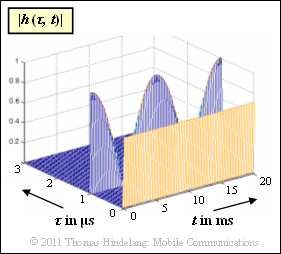Exercise 2.4: 2D Transfer Function
Dargestellt ist die zweidimensionale Impulsantwort $h(\tau, \hspace{0.05cm}t)$ eines Mobilfunksystems in Betragsdarstellung.
- Es ist zu erkennen, dass die 2D–Impulsantwort nur für die Verzögerungszeiten $\tau = 0$ und $\tau = 1 \ \rm µ s$ Anteile besitzt.
- Zu diesen Zeitpunkten gilt:
- $$h(\tau = 0\,{\rm µ s},\hspace{0.05cm}t) \hspace{-0.1cm} \ = \ \hspace{-0.1cm} \frac{1}{ \sqrt{2}} = {\rm const.}$$
- $$h(\tau = 1\,{\rm µ s},\hspace{0.05cm}t) \hspace{-0.1cm} \ = \ \hspace{-0.1cm} \cos(2\pi \cdot {t}/{ T_0})\hspace{0.05cm}.$$
Für alle anderen $\tau$–Werte ist $h(\tau, \hspace{0.05cm}t) \equiv 0$.
Gesucht ist die zweidimensionale Übertragungsfunktion $H(f, \hspace{0.05cm} t)$ als die Fouriertransformierte von $h(\tau, t)$ hinsichtlich der Verzögerungszeit $\tau$:
- $$H(f,\hspace{0.05cm} t) \hspace{0.2cm} \stackrel {f,\hspace{0.05cm}\tau}{\bullet\!\!-\!\!\!-\!\!\!-\!\!\circ} \hspace{0.2cm} h(\tau,\hspace{0.05cm}t) \hspace{0.05cm}.$$
Hinweise:
- Die Aufgabe gehört zum Kapitel Mehrwegeempfang beim Mobilfunk.
- Eine ähnliche Problematik wird in der Aufgabe 2.5 behandelt, allerdings mit veränderter Nomenklatur.
Fragebogen
Musterlösung
(2) Zum Zeitpunkt $t_1 \ \underline {= 5 \ \rm ms}$ ist $h(\tau = 1 \ {\rm µ s}, t_1) = 0$. Dementsprechend gilt
- $$h(\tau = 1\,{\rm µ s},\hspace{0.05cm}t_1) = \frac{1}{ \sqrt{2}} \cdot \delta(\tau)\hspace{0.3cm}\Rightarrow \hspace{0.3cm} H(f,\hspace{0.05cm}t_1) = \frac{1}{ \sqrt{2}} = {\rm const.}$$
Ebenso gilt für $t_2 \ \underline {= 15 \ \rm ms}$:
- $$h(\tau = 1\,{\rm µ s},\hspace{0.05cm}t_2) = \frac{1}{ \sqrt{2}} \cdot \delta(\tau)\hspace{0.3cm}\Rightarrow \hspace{0.3cm} H(f,\hspace{0.05cm}t_2) = \frac{1}{ \sqrt{2}} = {\rm const.}$$
(3) Zum Zeitpunkt $t = 0$ lautet die Impulsantwort mit $\tau_1 = 1 \ \rm µ s$:
- $$h(\tau,\hspace{0.05cm}t = 0) = \frac{1}{ \sqrt{2}} \cdot \delta(\tau)+ \delta(\tau - \tau_1)\hspace{0.05cm}.$$
Die Fouriertransformation führt zum Ergebnis:
- $$H_0(f) = H(f,\hspace{0.05cm}t = 0) \hspace{-0.1cm} \ = \ \hspace{-0.1cm} \frac{1}{ \sqrt{2}} + 1 \cdot {\rm e}^{- {\rm j}\cdot 2 \pi f \tau_1}=\frac{1}{ \sqrt{2}} + \cos( 2 \pi f \tau_1)- {\rm j}\cdot \sin( 2 \pi f \tau_1)$$
- $$\Rightarrow \hspace{0.3cm} |H_0(f)| \hspace{-0.1cm} \ = \ \hspace{-0.1cm} \sqrt { \left [ {1}/{ \sqrt{2}} + \cos( 2 \pi f \tau_1) \right ]^2 + \left [\sin( 2 \pi f \tau_1)\right ]^2}= \sqrt { 0.5 + 1 + {2}/{ \sqrt{2}} \cdot \cos( 2 \pi f \tau_1)} = \sqrt { 1.5 + { \sqrt{2}} \cdot \cos( 2 \pi f \tau_1)}\hspace{0.05cm}.$$
Daraus folgt:
- $H_0(f)$ ist periodisch mit $1/\tau_1 = 1 \ \rm MHz$.
- Für den Maximalwert bzw. Minimalwert gilt:
- $${\rm Max}\, \left [ \, |H_0(f)|\, \right ] \hspace{-0.1cm} \ = \ \hspace{-0.1cm} \sqrt { 1.5 + { \sqrt{2}} } \approx 1.707 \hspace{0.05cm},\hspace{0.5cm}{\rm Min}\, \left [ \, |H_0(f)|\, \right ] \hspace{-0.1cm} \ = \ \hspace{-0.1cm} \sqrt { 1.5 - { \sqrt{2}} } \approx 0.293 \hspace{0.05cm}. $$
- Bei $f = 0$ hat $|H_0(f)|$ ein Maximum.
Richtig sind demzufolge alle drei Lösungsvorschläge.
(4) Für den Zeitpunkt $t = 10 \ \rm ms$ gelten folgende Gleichungen:
- $$h(\tau,\hspace{0.05cm}t = 10\,{\rm ms}) \hspace{-0.1cm} \ = \ \hspace{-0.1cm} \frac{1}{ \sqrt{2}} \cdot \delta(\tau)- \delta(\tau - \tau_1)\hspace{0.05cm},$$
- $$H_{10}(f) = H(f,\hspace{0.05cm}t = 10\,{\rm ms}) \hspace{-0.1cm} \ = \ \hspace{-0.1cm} \frac{1}{ \sqrt{2}} - \cos( 2 \pi f \tau_1)+ {\rm j}\cdot \sin( 2 \pi f \tau_1)\hspace{0.05cm},$$
- $$ |H_{10}(f)| \hspace{-0.1cm} \ = \ \hspace{-0.1cm} \sqrt { 1.5 - { \sqrt{2}} \cdot \cos( 2 \pi f \tau_1)}\hspace{0.05cm}.$$
Richtig sind die Lösungsvorschläge 1 und 2:
- Die Frequenzperiode ändert sich gegenüber $t = 0$ nicht.
- Der Maximalwert ist weiterhin $1.707$ und auch der Minimalwert $0.293$ ändert sich nicht gegenüber der Teilaufgabe (3).
- Bei $f = 0$ gibt es nun ein Minimum und kein Maximum.
Die rechte Grafik zeigt den Betrag $|H(f, t)|$ der 2D–Übertragungsfunktion.

